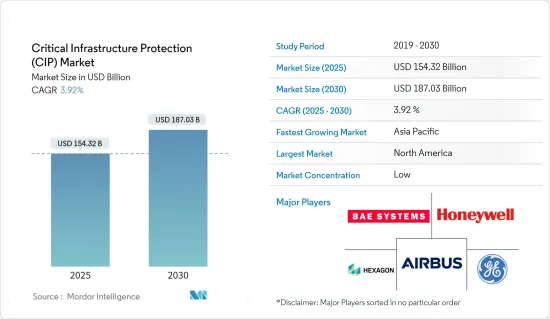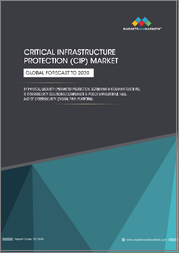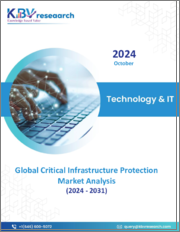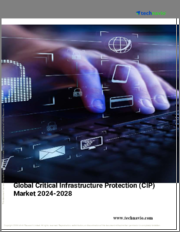
|
시장보고서
상품코드
1685807
중요 인프라 보호 : 시장 점유율 분석, 산업 동향 및 통계, 성장 예측(2025-2030년)Critical Infrastructure Protection (CIP) - Market Share Analysis, Industry Trends & Statistics, Growth Forecasts (2025 - 2030) |
||||||
중요 인프라 보호 시장 규모는 2025년에 1,543억 2,000만 달러에 달할 것으로 추정됩니다. 예측 기간(2025-2030년)의 CAGR은 3.92%를 나타낼 것으로 전망되고, 2030년에는 1,870억 3,000만 달러에 도달할 것으로 예상됩니다.

중요 인프라 보호 시장은 현대 사회의 원활한 진전과 동화를 지원하는 데 적극적이고 역동적인 역할을 수행하기 때문에 성장을 계속하고 있습니다. 중요 인프라의 성능, 안전성, 신뢰성, 지속적인 운영, 유지보수 및 보호는 전 세계적으로 국가적 우선순위가 되고 있습니다.
주요 하이라이트
- 중요 인프라(CI)는 사회를 지원하고 국가의 경제, 건강, 안보의 척추가 되는 중요한 서비스를 제공합니다. 가정, 산업, 운송 및 통신 시스템에서 사용되는 전력은 중요한 인프라의 일부입니다.
- 세계의 급속한 도시화로 도시 인프라에는 막대한 부하가 걸려 있으며, 각국 정부는 보다 살기 쉬운 환경을 제공하기 위해 교통, 에너지, 물 등 인프라의 충실에 힘을 쏟고 있습니다. 또한 정보통신분야도 이 시장에서 중요한 역할을 하고 있습니다.
- 또한 발전 및 유틸리티에서 빌딩 자동화 및 보안 시스템에 이르기까지 다양한 중요한 인프라와 운영 기술이 방위 기지와 시설을 널리 지원합니다. 이러한 기반이 파괴되면 전원 손실, 기밀 정보 유출, 업무 중단 등 국가의 경제 안보가 약화될 수 있습니다. 따라서 중요한 인프라 보호 문제는 정부, 인프라 관리자 및 지방 자치 단체에 대한 주요 관심사로 부상하고 있습니다. 유럽 연합(EU)은 중요 인프라 보호를 위한 유럽 프로그램(EPCIP)을 통해 모든 회원국과 국민에게 중요 인프라 보호(CIP)의 중요성을 발표했습니다.
- 산업용 제어 시스템 장비는 송전망과 같은 중요한 인프라에서 필수적인 역할을 합니다. 최근 여러 ICS 장비가 온라인으로 액세스할 수 있게 되어 잠재적인 보안 문제가 발생하고 있습니다. 그러나 사이버 공간에서 이러한 장비의 특성에 대해서는 깊은 이해를 얻지 못했습니다. 표준 기반의 기술적 보안 테스트의 부족은 산업 제어 환경과 중요한 국가 인프라를 사이버 공격의 위험에 노출시킵니다.
- COVID 후 원격으로 작업하는 사람이 늘어나 피싱 공격과 랜섬웨어 등 사이버 위협이 급증했습니다. 중요 인프라 운영자는 기존의 설치만큼 안전하지 않을 수 있는 새로운 근무 조건에 적응하면서 사이버 공격의 위험 증가에 직면했습니다. 이것이 유행 이후 큰 시장 성장으로 이어졌습니다.
중요 인프라 보호 시장 동향
큰 성장을 이루는 유지 보수 및 지원 서비스
- 유지보수 및 지원 서비스는 비즈니스 연속성을 위해 서비스 성능을 보장하기 위한 일련의 절차입니다. 이러한 서비스에는 하드웨어 및 소프트웨어 시스템의 정기적인 유지보수가 포함됩니다. 중요 인프라 유지 보수는 지속적인 운영에 필수적입니다. 따라서 사업개발 매니저와 중요 인프라의 소유자는 사업 운영의 핵심 및 조직의 중요한 보안 관련 영역을 보호하기 위해 많은 투자를 하고 있습니다.
- IT 네트워크와 달리 운영 기술(OT) 구성요소의 수명은 15년에서 25년과 수십년의 범위에 있으며, 이러한 시스템은 이러한 시대 지연 소프트웨어 및 하드웨어에 취약성과 구멍이 있기 때문에 사이버 공격의 대상이 되기 쉽습니다. 따라서 정기적인 유지 보수가 필요합니다.
- 에너지·발전·배전 네트워크에서는 급증하는 전력 수요에 대응하기 위해, 보수·서포트 서비스 수요가 높아지고 있습니다. 에너지 부문은 다른 모든 중요한 인프라 부문을 가능하게 하기 때문에 다른 면에서 볼 수 없을 정도로 중요합니다. 안정적이고 안전한 전력 네트워크가 없으면 경제와 지역 사회는 작동하지 않습니다. 방대한 공급망, 전력망, 고객 정보를 사이버 위협으로부터 보호하는 과제에 직면하고 있기 때문에 에너지·유틸리티 기업에 있어서 사이버 보안의 중요성이 높아지고 있습니다.
- 2023년 10월 구글 클라우드는 E-ISAC 공급업체 제휴 프로그램에 참여하고 중요한 취약성 및 보안 솔루션에 대한 전문 지식을 제공함으로써 전력 산업의 집단 방어에 기여했습니다. 벤더 제휴 프로그램의 파트너로서 구글 클라우드는 전력 분야의 변화와 안전을 보장하기 위해 업계 리더들과 함께 전문가를 투입합니다. 이 회사는 전력 산업을 사이버 공격으로부터 보호하기 위해 Google Cybersecurity Action Team을 파견합니다. Google은 또한 사이버 보안을 추진하기 위해 5년간 최소 100억 달러를 투자할 것을 약속합니다.
- 전반적으로 중요한 인프라를 보호하기 위해 공급망의 상호 의존성을 유지 및 지원하고, 랜섬웨어, 공급망 침해, 봇넷, 웜 공격 등을 포함한 사이버 공격 증가에 대한 집단적 방어를 강화하기 위해 산업계와 벤더 간의 협력이 높아지고 있음이 조사한 시장에서 이 분야의 성장을 가속하고 있습니다.
북미가 큰 시장 점유율을 차지할 전망
- 미국에서 중요한 인프라 보호(CIP)의 채택은 중요한 시스템과 자산을 보호하고 국가 안보를 확보할 필요성에 의해 추진되는 종합적이고 발전적인 프로세스가 되고 있습니다.
- 에너지 분야에서는 연방 에너지 규제위원회(FERC)와 같은 규제기관이 송전망과 에너지·인프라의 보안을 확보하기 위한 기준을 실시했습니다. 송전망과 유틸리티의 디지털화가 진행됨에 따라 사이버 보안에 중점을 두어야 합니다. 국토 안보부(DHS)와 사이버 보안 인프라 안보국(CISA)은 이러한 시스템을 사이버 위협으로부터 보호하는 데 중요한 역할을 합니다.
- 미국의 전력 부문에는 6,413개 이상의 발전소가 있으며 약 1,075 기가와트의 발전 설비가 설치되어 있습니다. 미국의 에너지 및 전력 산업에서는 중요한 자산을 보호하기 위해 RADAR 보안 기술의 도입이 진행되고 있습니다. 경제, 공공 안전, 업무 연속성, 환경 보전에 대한 우려는 전력 회사와 유틸리티 회사의 사이버 보안을 최우선 과제로 삼고 있습니다.
- 스마트 시티와 교통 시스템은 디지털 기술에 크게 의존하고 사이버 공격에 노출됩니다. CIP는 이러한 위험을 줄이기 위해 강력한 사이버 보안 전략과 위협 인텔리전스를 개발하고 있습니다. 운송부문은 운수부(DoT)의 관할하에 있으며 공항 및 대량 운송 시스템을 포함한 운송 인프라의 안전 확보에 관한 규제를 실시했습니다.
- 교통부는 국가 인프라를 새롭게 하는 연방 정부의 이니셔티브를 주도하고 있습니다. 교통부는 초당파 인프라법에 근거한 엄청난 투자를 통해 사이버 보안 통합에 주목하고 있습니다. 이 이니셔티브는 주로 주와 지방 수준에서 이루어집니다. 또한 2023년 5월 일리노이 공과대학의 이니셔티브는 새로운 Tier 1 운송 센터를 설립하기 위해 1,000만 달러의 연방 보조금을 받았으며 네비게이션 시스템의 사이버 보안을 더욱 강화했습니다.
- 2023년 3월 연방수사국(FBI)은 보고서를 발표했습니다. 이에 따르면 전년 FBI는 미국 전역에서 랜섬웨어 공격에 대한 보고를 받았고, 3분의 1 이상이 중요한 인프라 부문 조직에 영향을 주었습니다. 보고된 2,385건의 랜섬웨어 인시던트 중 870건이 중요한 인프라 사업체를 대상으로 했습니다. 중요 인프라 부문을 대상으로 하는 랜섬웨어 공격의 다발은 견고한 중요 인프라 보호 대책의 필요성을 강조하고 있습니다. 이와 관련하여 미국 사이버 보안 및 인프라 보안국(CISA)은 2023년 5월 랜섬웨어 공격으로부터 중요한 인프라 조직의 시스템을 보호하기 위한 안전 확보 지원 프로그램 '랜섬웨어 취약성 경고 파일럿(RVWP)'을 시작했습니다.
- 캐나다 정부는 주로 캐나다 공공 안전국을 통해 중요한 인프라 보호를 조정하고 강화하기 위해 적극적으로 노력해 왔습니다. 디지털 인프라의 중요성이 커짐에 따라 캐나다는 중요한 시스템의 사이버 보안 강화에 주력해 왔습니다. 여기에는 사이버 위협으로부터 보호하기 위한 규제와 기준도 포함됩니다.
- 캐나다 정부에 따르면, 랜섬웨어는 캐나다 국민들에게 석유 및 가스의 안정적인 공급에 대한 주요 사이버 위협이라는 사실은 확실히, 캐나다에서 석유 및 가스 공급의 중단을 의도하는 사이버 위협 행위자의 가장 가능성있는 표적은 석유의 변속과 처리 단계에서의 병목입니다. 타겟이 될 수 있는 것은 대구경 파이프라인의 업무·OT 네트워크, 중계 터미널, 주요 정제 시설 등입니다.
중요 인프라 보호 시장 개요
중요 인프라 보호 시장은 Bae Systems PLC, Honeywell International Inc., Airbus SE, Hexagon AB, General Electric Company와 같은 대기업이 존재하며 매우 세분화되어 있습니다. 시장 기업은 제품 라인업을 강화하고 지속 가능한 경쟁 우위를 얻기 위해 제휴 및 인수와 같은 전략을 채택합니다.
- 2023년 9월 - 에릭슨은 구글 클라우드와의 수년간 양호한 파트너십 확대를 발표하고, 통합된 자동화와 오케스트레이션을 제공하며, AI/ML을 활용하여 통신 서비스 제공업체(CSP)의 기타 혜택을 추가하는 에릭슨 클라우드 RAN 솔루션을 개발한다고 발표했습니다. 구글 디스트리뷰티드 GDC는 Google Cloud 인프라와 서비스를 에지 및 데이터센터로 확장하는 완벽하게 관리되는 하드웨어 및 소프트웨어 포트폴리오입니다. GDC Edge에 에릭슨의 Cloud RAN을 도입하면 완전히 자동화된 초대형 분산 클라우드를 제공할 수 있어 효율적이고 안정적이며 성능이 뛰어나고 안전한 소프트웨어 중심 무선 액세스 네트워크 인프라를 구현할 수 있습니다.
- 2023년 6월 - 온라인 보호의 세계 기업인 McAfee Corp.는 Dell Technologies와 공동으로 중소기업 소유자를 위한 새로운 종합적인 보안 솔루션 McAfee Business Protection을 발표했습니다. McAfee Business Protection은 Dell의 중소기업 고객이 사이버 위협과 취약성을 피할 수 있도록 수상 경력이 있는 보안, ID 및 어두운 웹 데이터 모니터링, VPN, 보안 브라우징을 위한 웹 보호 등을 제공합니다.
기타 혜택 :
- 엑셀 형식 시장 예측(ME) 시트
- 3개월간의 애널리스트 서포트
목차
제1장 서론
- 조사의 전제조건과 시장 정의
- 조사 범위
제2장 조사 방법
제3장 주요 요약
제4장 시장 인사이트
- 시장 개요
- 업계의 매력도 - Porter's Five Forces 분석
- 공급기업의 협상력
- 구매자의 협상력
- 신규 참가업체의 위협
- 대체품의 위협
- 경쟁 기업 간 경쟁 강도
- 시장에 대한 COVID-19의 영향 평가
- 이용 사례 분석 - 최종 사용자별
제5장 시장 역학
- 시장 성장 촉진요인
- 스마트 그리드 기술에 대한 막대한 투자
- 물리적 위협, 사이버 위협, 내부자 공격
- 클라우드 컴퓨팅과 중요 인프라 보호의 공동 기능
- 보다 좋은 규제와 구현을 요구하는 정치적 압력
- 시장 성장 억제요인
- 산업용 제어 시스템에 대한 이해 부족
- 제품 간 상호 운용성의 부족
- 시장 기회
- 정보·물리 보안 시장을 견인하는 IoT
제6장 시장 세분화
- 제품별
- 보안 기술
- 네트워크 보안
- 물리적 보안
- 선별 및 스캔
- 영상 감시
- PSIM과 PIAM
- 액세스 제어
- 차량 식별 관리
- 건물 관리 시스템
- 보안 통신
- 레이더
- SCADA 보안
- CBRNE
- 보안 기술
- 서비스별
- 위험 관리 서비스
- 설계, 통합, 상담
- 매니지드 서비스
- 유지보수 및 지원
- 업계별
- 에너지 및 전력
- 수송
- 기밀성이 높은 인프라와 기업
- 지역별
- 북미
- 미국
- 캐나다
- 유럽
- 독일
- 영국
- 프랑스
- 이탈리아
- 아시아
- 중국
- 일본
- 인도
- 호주 및 뉴질랜드
- 라틴아메리카
- 브라질
- 아르헨티나
- 멕시코
- 중동 및 아프리카
- 아랍에미리트(UAE)
- 사우디아라비아
- 남아프리카
- 터키
- 북미
제7장 벤더의 시장 점유율 분석
제8장 경쟁 구도
- 기업 프로파일
- BAE Systems PLC
- Honeywell International Inc.
- Airbus SE
- Hexagon AB
- General Electric Company
- McAfee Corp.
- Waterfall Security Solutions
- General Dynamics Corporation
- Lockheed Martin Corporation
- Northrop Grumman Corp.
- Kaspersky Lab Inc.
- Ericsson AB
제9장 투자 분석
제10장 시장의 미래
KTH 25.04.02The Critical Infrastructure Protection Market size is estimated at USD 154.32 billion in 2025, and is expected to reach USD 187.03 billion by 2030, at a CAGR of 3.92% during the forecast period (2025-2030).

The critical infrastructure protection (CIP) market is growing as it plays an active and dynamic part in helping modern society's seamless progression and assimilation. The performance, safety, reliability, continuous operation, maintenance, and protection of critical infrastructure are national priorities across the globe.
Key Highlights
- Critical infrastructure (CI) offers essential services that underpin society and serve as the spine of any nation's economy, health, and security. The power used in homes and industries, transportation, and communication systems is a part of critical infrastructure.
- Due to rapid urbanization worldwide, there has been immense stress on city infrastructure, and governments are focusing on enhancing the infrastructure, such as transport, energy, and water, to provide better livability. The information and the telecommunications sector also play a crucial role in the market.
- Furthermore, various critical infrastructure and operational technologies widely support defense bases and facilities, from power generation and utilities to building automation and security systems. Destruction of these bases can weaken national economic security, such as loss of power, exposure of confidential information, interruptions to operations, etc. Therefore, the issue of critical infrastructure protection is emerging as a primary concern for governments, infrastructure managers, and local authorities. The European Union (EU), through its European Program for Critical Infrastructure Protection (EPCIP), announced the significance of CIP to all its member states and citizens.
- Industrial control system devices play an essential role in critical infrastructures, such as the power grid. In recent years, various ICS devices have been accessible online, resulting in potential security issues. However, there is a lack of deep understanding of the characteristics of these devices in cyberspace. A lack of standard-based technical security testing puts the industrial control environments and critical national infrastructure at risk of cyberattacks.
- Post-COVID, with more people working remotely, there was a surge in cyber threats, including phishing attacks and ransomware. Critical infrastructure operators faced an increased risk of cyber-attacks as they adapted to new working conditions that might not have been as secure as their traditional setups. This has lead to major market growth post pandemic.
Critical Infrastructure Protection (CIP) Market Trends
Maintenance and Support Services to Witness Major Growth
- Maintenance and support services are a set of procedures designed to ensure the performance of the service for business continuity. These services include maintenance of hardware and software systems on a regular basis. Maintenance of critical infrastructure is essential for continuous operation. Damage to a critical infrastructure may have a significant negative impact; therefore, business development managers and owners of critical infrastructure are investing significantly to protect the core of business operations and critical security-related areas of the organization.
- Unlike IT networks, the lifetimes of operational technology (OT) components are in the range of decades, varying from 15 to 25 years, and these systems become an easy target for cyberattacks because of the vulnerabilities and holes in such outdated software and hardware. Therefore, they need to be maintained regularly.
- Energy and power generation and distribution networks are observing a growing demand for maintenance and support services to keep pace with dramatically increasing electricity demand. The energy sector is uniquely critical because it enables all other critical infrastructure sectors. Without reliable and secure electricity networks, economies and communities cannot function. This has increased the importance of cybersecurity for energy and utility companies because they face the challenges of protecting vast supply chains, electricity grids, and customer information from cyber threats.
- In October 2023, Google Cloud joined the E-ISAC Vendor Affiliate Program to contribute to the electricity industry's collective defense by providing subject matter expertise on critical vulnerabilities and security solutions. As a Vendor Affiliate Program partner, Google Cloud will devote experts to working alongside industry leaders to transform and secure the electricity sector. The company will bring the Google Cybersecurity Action Team to protect the electricity industry against cyberattacks. Google has also committed to investing at least USD 10 billion over five years to advance cybersecurity.
- Overall, the growing collaboration between industry and vendors for the maintenance and support of supply chain interdependencies and strengthening their collective defense against growing cyberattacks that include ransomware, supply chain compromise, botnets, and worm attacks to protect critical infrastructure is propelling the segment growth in the market studied.
North America is Expected to Hold Significant Market Share
- The adoption of critical infrastructure protection (CIP) in the United States has been a comprehensive and evolving process driven by the need to secure vital systems and assets, ensuring national security.
- In the energy sector, regulatory bodies like the Federal Energy Regulatory Commission (FERC) enforce standards to ensure the security of power grids and energy infrastructure. The increasing digitization of power grids and utilities necessitates a strong focus on cybersecurity. The Department of Homeland Security (DHS) and the Cybersecurity and Infrastructure Security Agency (CISA) play vital roles in protecting these systems from cyber threats.
- The United States electricity segment contains more than 6,413 power plants with approximately 1,075 gigawatts of installed generation. The energy and power industry across the United States is experiencing a significant uptake of RADAR security technologies to safeguard critical assets. Concerns regarding the economy, public safety, operational continuity, and environmental well-being have elevated cybersecurity as a foremost priority for power and utility companies.
- Smart cities and transportation systems heavily rely on digital technologies, which expose them to cyberattacks. CIP develops robust cybersecurity strategies and threat intelligence to mitigate these risks. The transportation sector falls under the purview of the Department of Transportation (DoT), which enforces regulations for securing transportation infrastructure, including airports and mass transit systems.
- The Department of Transportation is leading federal initiatives to revamp the country's infrastructure. They have a major focus on integrating cybersecurity through significant investments under the Bipartisan Infrastructure Law. This endeavor primarily takes place at the state and local levels. Moreover, in May 2023, Illinois Tech's initiatives received a USD 10 million federal grant to establish a new Tier 1 transportation center, further strengthening cybersecurity in navigation systems.
- In March 2023, the Federal Bureau of Investigation (FBI) published a report. It stated that in the previous year, the FBI received reports of ransomware attacks across the country, with more than one-third affecting organizations in the critical infrastructure sectors. Out of the 2,385 ransomware incidents reported, 870 targeted critical infrastructure entities. The high incidence of ransomware attacks targeting critical infrastructure sectors underscores the need for robust critical infrastructure protection measures. In reference to this, in May 2023, the US Cybersecurity & Infrastructure Security Agency (CISA) launched the Ransomware Vulnerability Warning Pilot (RVWP) program to help secure critical infrastructure organizations to protect their systems from ransomware attacks.
- The Canadian Government, primarily through Public Safety Canada, has been actively engaged in coordinating and enhancing critical infrastructure protection. With the increasing importance of digital infrastructure, Canada has been concentrating on enhancing cyber security for critical systems. This includes regulations and standards to safeguard against cyber threats.
- As per the Canadian Government, ransomware is almost certainly the primary cyber threat to the reliable supply of oil and gas to Canadians, and the most likely targets for cyber threat actors intending to disrupt the oil and gas supply in Canada are bottlenecks in the oil transmission and processing stages. Potential targets include large-diameter pipelines' business and OT networks, transfer terminals, and major refining facilities.
Critical Infrastructure Protection (CIP) Market Overview
The Critical Infrastructure Protection Market is highly fragmented, with the presence of major players Bae Systems PLC, Honeywell International Inc., Airbus SE, Hexagon AB, and General Electric Company. Players in the market are adopting strategies such as partnerships and acquisitions to enhance their product offerings and gain sustainable competitive advantage.
- September 2023 - Ericsson announced an expansion of its successful and long-standing partnership with Google Cloud to develop an Ericsson Cloud RAN solution on Google Distributed Cloud (GDC) that offers integrated automation and orchestration and leverages AI/ML for additional communications service providers (CSP) benefits. GDC is a fully managed hardware and software portfolio that extends Google Cloud's infrastructure and services to the edge and into the data centers. Deploying Ericsson Cloud RAN on GDC Edge enables the delivery of a fully automated and very large-scale distributed cloud, resulting in an efficient, reliable, highly performant, and secured software-centric radio access network infrastructure.
- June 2023 - McAfee Corp., a global player in online protection, announced McAfee Business Protection, a new comprehensive security solution for small business owners in collaboration with Dell Technologies. McAfee Business Protection helps Dell small business customers avoid cyber threats and vulnerabilities with award-winning security, identity and dark web data monitoring, VPN, web protection for safe browsing, and more.
Additional Benefits:
- The market estimate (ME) sheet in Excel format
- 3 months of analyst support
TABLE OF CONTENTS
1 INTRODUCTION
- 1.1 Study Assumptions and Market Definition
- 1.2 Scope of the Study
2 RESEARCH METHODOLOGY
3 EXECUTIVE SUMMARY
4 MARKET INSIGHTS
- 4.1 Market Overview
- 4.2 Industry Attractiveness - Porter's Five Forces Analysis
- 4.2.1 Bargaining Power of Suppliers
- 4.2.2 Bargaining Power of Buyers
- 4.2.3 Threat of New Entrants
- 4.2.4 Threat of Substitutes
- 4.2.5 Degree of Competition
- 4.3 An Assessment of the Impact of COVID-19 on the Market
- 4.4 Use Case Analysis- By End-Users
5 MARKET DYNAMICS
- 5.1 Market Drivers
- 5.1.1 Enormous Investments in Smart Grid Technology
- 5.1.2 Physical Threats, Cyber Threats, and Insider Attacks
- 5.1.3 Joint Functioning of Cloud Computing and Critical Infrastructure Protection
- 5.1.4 Political Pressures for Better Regulations and Implementations
- 5.2 Market Restraints
- 5.2.1 Poor Understanding of Industrial Control Systems
- 5.2.2 Lack of Interoperability Between Products
- 5.3 Market Opportunities
- 5.3.1 IoT Driving the Information and Physical Security Market
6 MARKET SEGMENTATION
- 6.1 By Offering
- 6.1.1 Security Technology
- 6.1.1.1 Network Security
- 6.1.1.2 Physical Security
- 6.1.1.2.1 Screening and Scanning
- 6.1.1.2.2 Video Surveillance
- 6.1.1.2.3 PSIM and PIAM
- 6.1.1.2.4 Access Control
- 6.1.1.3 Vehicle Identification Management
- 6.1.1.4 Building Management Systems
- 6.1.1.5 Secure Communications
- 6.1.1.6 Radars
- 6.1.1.7 SCADA Security
- 6.1.1.8 CBRNE
- 6.1.1 Security Technology
- 6.2 By Services
- 6.2.1 Risk Management Services
- 6.2.2 Designing, Integration, and Consultation
- 6.2.3 Managed Services
- 6.2.4 Maintenance and Support
- 6.3 By Vertical
- 6.3.1 Energy and Power
- 6.3.2 Transportation
- 6.3.3 Sensitive Infrastructure and Enterprises
- 6.4 By Geography
- 6.4.1 North America
- 6.4.1.1 United States
- 6.4.1.2 Canada
- 6.4.2 Europe
- 6.4.2.1 Germany
- 6.4.2.2 United Kingdom
- 6.4.2.3 France
- 6.4.2.4 Italy
- 6.4.3 Asia
- 6.4.3.1 China
- 6.4.3.2 Japan
- 6.4.3.3 India
- 6.4.4 Australia and New Zealand
- 6.4.5 Latin America
- 6.4.5.1 Brazil
- 6.4.5.2 Argentina
- 6.4.5.3 Mexico
- 6.4.6 Middle East and Africa
- 6.4.6.1 United Arab Emirates
- 6.4.6.2 Saudi Arabia
- 6.4.6.3 South Africa
- 6.4.6.4 Turkey
- 6.4.1 North America
7 VENDOR MARKET SHARE ANALYSIS
8 COMPETITIVE LANDSCAPE
- 8.1 Company Profiles
- 8.1.1 BAE Systems PLC
- 8.1.2 Honeywell International Inc.
- 8.1.3 Airbus SE
- 8.1.4 Hexagon AB
- 8.1.5 General Electric Company
- 8.1.6 McAfee Corp.
- 8.1.7 Waterfall Security Solutions
- 8.1.8 General Dynamics Corporation
- 8.1.9 Lockheed Martin Corporation
- 8.1.10 Northrop Grumman Corp.
- 8.1.11 Kaspersky Lab Inc.
- 8.1.12 Ericsson AB

















